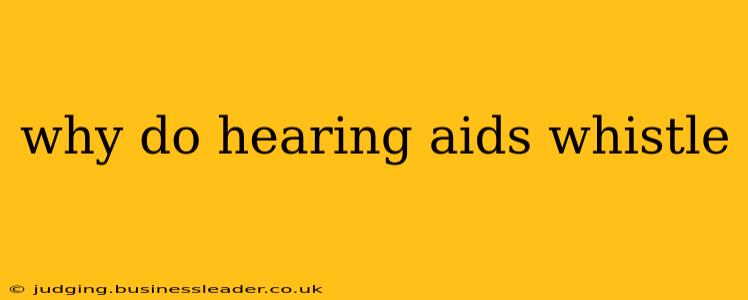Hearing aids are designed to amplify sound, improving your ability to hear conversations and environmental noises. However, sometimes a high-pitched squeal or whistle can occur, a phenomenon known as feedback. This frustrating issue can significantly impact the user experience, making it crucial to understand its causes and solutions.
What Causes Hearing Aid Whistle?
The most common reason for hearing aid whistling is positive feedback. This occurs when sound amplified by the hearing aid escapes the ear canal, is picked up by the microphone, and then re-amplified, creating a continuous loop. Imagine a microphone placed too close to a speaker; the same principle applies here. Several factors contribute to this feedback loop:
- Poor fit: A hearing aid that doesn't fit snugly in the ear canal leaves gaps for sound to escape. This is arguably the most frequent cause of whistling. Even slight imperfections in the earmold can create these crucial escape routes.
- Incorrect earmold: An improperly designed or manufactured earmold can also create spaces allowing sound leakage. A custom-fitted earmold is essential for optimal performance and to minimize feedback.
- Obstructions in the ear canal: Earwax buildup, fluid, or other obstructions in the ear canal can affect the seal and contribute to whistling. Regular cleaning is paramount.
- Damaged hearing aid: A malfunctioning component within the hearing aid itself can also lead to feedback. This might involve a problem with the microphone, amplifier, or other internal parts.
- Improper volume settings: Setting the volume too high can increase the likelihood of feedback. The hearing aid might be trying to amplify sounds already present in the environment, leading to the whistle.
- External factors: Strong environmental sounds, such as wind, can also contribute to feedback.
How Can I Stop My Hearing Aid From Whistling?
Addressing the whistle requires identifying the root cause. Here's what you can do:
1. Check the Fit and Seal:
- Clean your ear: Ensure your ear canal is free from earwax or debris.
- Inspect the earmold: Look for any cracks or damage to the earmold.
- Reinsert the hearing aid: Make sure the hearing aid is properly seated in your ear.
2. Adjust the Volume:
- Lower the volume: Try reducing the volume setting. Often, lowering the volume by even a small amount can eliminate the whistle.
3. Consult Your Audiologist:
If the whistling persists despite these steps, it's crucial to schedule an appointment with your audiologist. They can:
- Inspect your hearing aid: They will examine your hearing aid for any damage or malfunctions.
- Adjust settings: They can fine-tune the settings of your hearing aid to minimize or eliminate feedback.
- Refit your earmold: If necessary, they may recommend a new earmold for a better fit.
- Replace your hearing aid: In some cases, a damaged hearing aid might require replacement.
What if My Hearing Aid Still Whistles After Adjustments?
Even after adjustments, some persistent whistling might occur. This could indicate more complex issues, such as:
- Need for a different hearing aid model: Your current model might not be suitable for your specific hearing loss or ear canal anatomy.
- Underlying medical condition: In rare cases, underlying medical conditions might contribute to feedback issues.
Always consult your audiologist for any persistent problems with your hearing aid. They are best equipped to diagnose the issue and provide effective solutions.
How Often Should I Have My Hearing Aids Checked?
Regular check-ups with your audiologist are essential for maintaining the health and effectiveness of your hearing aids. They should be checked at least once a year, or more frequently if you experience problems like feedback. Preventative maintenance helps prolong the life of your hearing aids and ensures optimal hearing performance.
By understanding the causes of hearing aid whistling and taking the appropriate steps, you can minimize this frustrating problem and enjoy clearer, more comfortable hearing. Remember, regular maintenance and consultation with your audiologist are key to successful hearing aid use.
